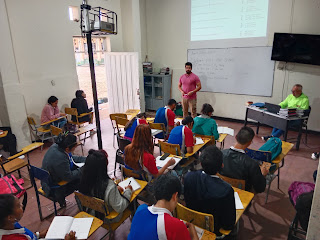proposal to improve the oral skills of the students
Yes, yes, it is usually a bit complex to talk about so many things, however, I will be very punctual, I want you to have the advantage of easily observing what a teacher candidate in participant observation practices should do.🎓🔍
1. Link to MY LESSON PLANS:
2. Context of my school:
- Greeting
- Called for assistance.
- Feedback on the last viewed topic.
- Explanation of activity.
- round of questions
- Execution of activity.
- Recommendations for the next class.
3. The description of the observed population.
During my observation process, the institution assigned me 5 groups of students, it should be noted that we are talking about young people and adults who decided to validate their basic and secondary studies, through the program offered by the institution on Saturdays.
These groups are eighth, ninth, tenth, and eleventh grade. There you can find a variety of groups that have students who are close to the elderly, in the same way, there are very young students who did not want to develop their academic bachelor's degree on a regular basis.
On the other hand, these groups gather people from a vulnerable socio-economic context. This implies that the groups have different focuses on attention and performance. Communication channels must be enabled to find out if they are paying attention to the sessions or if the issues have been understood.
5. Photographic evidence.
6. Proposal to improve the oral skills of the students
I have in mind two special ideas to improve the abilities in my students that I think I will not forget and have marked my path as a future teacher:
1. The first time I went to practice and the English teacher asked me to direct the reading for the next group, the activity consisted of projecting the material with the video - bean, which consists of a reading comprehension text with multiple choice questions related to the importance of the use of webs in the life of spiders and the benefits they have; The photocopies with the information were also distributed to the students. After having done so, I began with the interpretation of the text, identification of known words, and learning of new ones, giving meaning and coherence to the reading, this took half an hour, then with the teacher. We talked about the fact that 70% of the class should be in English and mime or synonyms were used in the explanation of new words but in English so that they had a greater participation; At the end of the reading they go to the part of the 8 questions, 5 of them multiple choice and the remaining 3 were open questions, the reading was done question by question with their answer options and in this way work was done in a collaborative and at the same time individual where each student was responding, making it easier for everyone to work at the same pace.
- Cooperative Language Learning
2. One of the most interesting methodological proposals for me is cooperative learning, which is based on studies by great educators and psychologists such as Jean Piaget (for example, 1965) and Lev Vygotsky (for example, 1962). They had already been talking about the development of communication skills in more natural contexts and it is because they thought that this model is the most optimal of all, because many people have quickly learned English or another language to the extent that they express it in communicatively active environments. Thus, this theory maintains that learners develop communicative skills by conversing in socially or pedagogically structured situations. 
This theory also seeks that people acquire critical thinking, in this way it can be understood that this thinking can be put at the same level of focus as that of the basic linguistic skills of reading, writing, listening comprehension and oral expression (Kagan 1992 ).
7. Conclusions about my experience and observations
- The teacher must establish dynamics that, although initially the communication is complex with the students, this aspect will improve to the extent that the teacher returns to his students as part of the class examples, this interaction exercise allows knowledge to spread consolidating in a natural way, because by putting them as examples or as interlocutors, they recover their attention on the subject and in this way knowledge can flow better.
- I think that this methodology with traditionalist overtones works well in the context, however, it could create other tools that will help you not wear yourself out so much and thus manage to keep the attention of the students more consciously. I mean constructivist learning in which the main learning ideas were developed by Jean Piaget. However, unlike the traditional system, which is based on memorization and repetition, or on the idea that the teacher is the one who knows everything, this learning model seeks that the same student builds his own knowledge based on previous teachings. This way you could create awareness of knowledge, such as interacting with real dialogues between themselves or with the school's own things.
- Finally, I can conclude that a structured plan on academic processes helps the teacher to have a lot of peace of mind in each of the relationship spaces. This empowerment occurs because by organizing all their knowledge and strategies they will allow them to quickly overcome setbacks.










Comentarios
Publicar un comentario